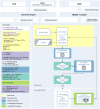Modernizing the NEURON Simulator for Sustainability, Portability, and Performance
- PMID: 35832575
- PMCID: PMC9272742
- DOI: 10.3389/fninf.2022.884046
Modernizing the NEURON Simulator for Sustainability, Portability, and Performance
Abstract
The need for reproducible, credible, multiscale biological modeling has led to the development of standardized simulation platforms, such as the widely-used NEURON environment for computational neuroscience. Developing and maintaining NEURON over several decades has required attention to the competing needs of backwards compatibility, evolving computer architectures, the addition of new scales and physical processes, accessibility to new users, and efficiency and flexibility for specialists. In order to meet these challenges, we have now substantially modernized NEURON, providing continuous integration, an improved build system and release workflow, and better documentation. With the help of a new source-to-source compiler of the NMODL domain-specific language we have enhanced NEURON's ability to run efficiently, via the CoreNEURON simulation engine, on a variety of hardware platforms, including GPUs. Through the implementation of an optimized in-memory transfer mechanism this performance optimized backend is made easily accessible to users, providing training and model-development paths from laptop to workstation to supercomputer and cloud platform. Similarly, we have been able to accelerate NEURON's reaction-diffusion simulation performance through the use of just-in-time compilation. We show that these efforts have led to a growing developer base, a simpler and more robust software distribution, a wider range of supported computer architectures, a better integration of NEURON with other scientific workflows, and substantially improved performance for the simulation of biophysical and biochemical models.
Keywords: NEURON; computational neuroscience; multiscale computer modeling; neuronal networks; simulation; systems biology.
Copyright © 2022 Awile, Kumbhar, Cornu, Dura-Bernal, King, Lupton, Magkanaris, McDougal, Newton, Pereira, Săvulescu, Carnevale, Lytton, Hines and Schürmann.
Conflict of interest statement
The authors declare that the research was conducted in the absence of any commercial or financial relationships that could be construed as a potential conflict of interest.
Figures










References
-
- Agullo E., Demmel J., Dongarra J., Hadri B., Kurzak J., Langou J., et al. . (2009). Numerical linear algebra on emerging architectures: the PLASMA and MAGMA projects. J. Phys. 180, 012037. 10.1088/1742-6596/180/1/012037 - DOI
-
- Akar N. A., Cumming B., Karakasis V., Küsters A., Klijn W., Peyser A., et al. . (2019). “Arbor–a morphologically-detailed neural network simulation library for contemporary high-performance computing architectures,” in 2019 27th Euromicro International Conference on Parallel, Distributed and Network-Based Processing (PDP) (Pavia: ), 274–282.
-
- Ascoli G. A., Donohue D. E., Halavi M. (2007). NeuroMorpho.Org: a central resource for neuronal morphologies. J. Neurosci. 27, 9247–9251. 10.1523/JNEUROSCI.2055-07.2007 - DOI - PMC - PubMed
Grants and funding
LinkOut - more resources
Full Text Sources

